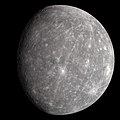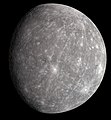Ӳкерчĕк:Mercury in true color.jpg

Ҫак умкурӑмӑн виҫи: 600 × 600 пиксел. Ытти разрешенисем: 240 × 240 пиксел | 480 × 480 пиксел | 768 × 768 пиксел | 1040 × 1040 пиксел.
Оригиналлӑ файл ((1040 × 1040 пиксел, файл пысăкăше: 408 Кб, MIME-тĕсĕ: image/jpeg))
Файл историйĕ
Вӑхӑт ҫине пуссан, ун чухнехи версине пӑхма пулать.
| Дата/Вăхăт | Миниатюра | Калӑпӑш | Хутшăнакан | Асăрхав | |
|---|---|---|---|---|---|
| хальхи | 08:16, 15 Ҫу уйӑхӗн 2023 |  | 1040 × 1040 (408 Кб) | CactiStaccingCrane | Reverted to version as of 10:42, 24 July 2022 (UTC) |
| 08:01, 15 Ҫу уйӑхӗн 2023 |  | 1024 × 1024 (837 Кб) | CactiStaccingCrane | Manually merge the original monochrome image with the calibrated color image to eek out more resolution | |
| 10:42, 24 Утӑ уйӑхӗн 2022 |  | 1040 × 1040 (408 Кб) | JCP-JohnCarlo | Make this planet image center | |
| 10:25, 24 Утӑ уйӑхӗн 2022 |  | 1040 × 1040 (710 Кб) | JCP-JohnCarlo | Canvas image | |
| 09:00, 3 Чӳк уйӑхӗн 2019 |  | 960 × 1040 (865 Кб) | Mirecki | User created page with UploadWizard |
Файлпа усă курни
Ку файлпа ҫак 1 страницӑра усӑ курнӑ:
Файлпа глобаллӑ усӑ курасси
Ку файлпа ҫак викисенче усӑ курнӑ:
- af.wikipedia.org усӑ курасси
- als.wikipedia.org усӑ курасси
- ar.wikibooks.org усӑ курасси
- as.wikipedia.org усӑ курасси
- be-tarask.wikipedia.org усӑ курасси
- beta.wikiversity.org усӑ курасси
- bn.wikibooks.org усӑ курасси
- bo.wikipedia.org усӑ курасси
- br.wikipedia.org усӑ курасси
- ceb.wikipedia.org усӑ курасси
- ckb.wiktionary.org усӑ курасси
- csb.wikipedia.org усӑ курасси
- cy.wikipedia.org усӑ курасси
- de.wikipedia.org усӑ курасси
- dty.wikipedia.org усӑ курасси
- dz.wikipedia.org усӑ курасси
- eml.wikipedia.org усӑ курасси
- en.wikipedia.org усӑ курасси
- Mercury (planet)
- Terrestrial planet
- The Planets
- Timeline of discovery of Solar System planets and their moons
- List of Solar System objects by size
- List of gravitationally rounded objects of the Solar System
- User:Kwamikagami/sandbox
- NASA
- User:Kazkaskazkasako/Books/Physical sciences
- Talk:Mercury (planet)/Archive 3
- User:Nrco0e/Userboxes
- User:Applekle/sandbox
- Wikipedia:Userboxes/Location/Extraterrestrial
- Talk:The Planets/GA1
- User:Double sharp/Largest Solar System objects
- User:TomMasterReal
- User:Nrco0e/Userboxes/FavMercury
- User:KeroseneLover100/sandbox/sandbox
- en.wikibooks.org усӑ курасси
- en.wiktionary.org усӑ курасси
- eo.wikipedia.org усӑ курасси
- es.wikipedia.org усӑ курасси
Ку файлпа глобальлӗ епле усӑ курнине пӑх.


